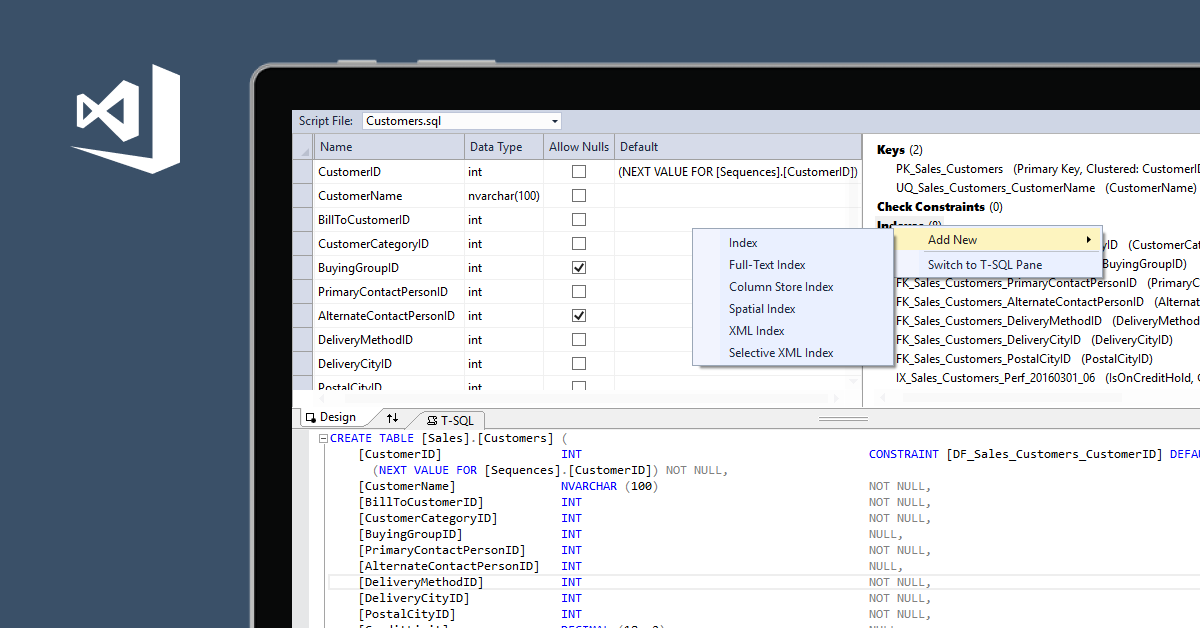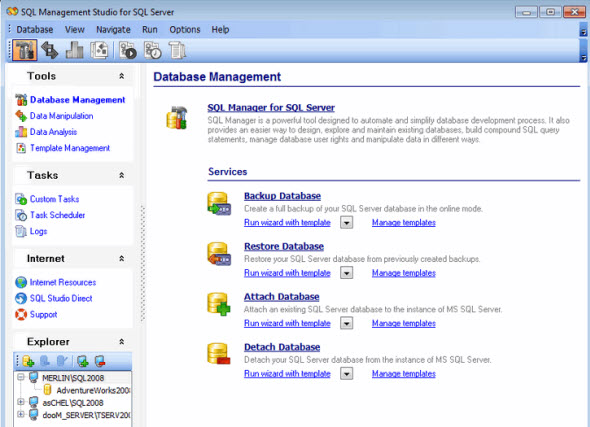When it comes to databases, MySQL is a big player and widely used. Today we'll be looking at some MySQL clients we can use on Mac to view these databases.
TL;DR: My personal favorite for Mac is TablePlus. It offers a free variant which is sufficient enough.
Since DBeaver is open-source, you can download it FREE for Windows, Linux, MAC, or Solaris. DbForge by Devart got suites of a database (SQL Server, MySQL, Oracle, PostgreSQL) related product to help you with development & administration. One of the favorite products by Devart is dbForge Studio, a powerful IDE for database management. Answer (1 of 2): Check out TablePlus - a native client for relational databases client on Mac. It works well with MS SQL Server. Notable features:. Native build optimized for performance. Modern design. Smart SQL query editor. Data schema design tool. Spreadsheet-like view data editor. Download SQL Server Management Studio (SSMS) 18.9.2. SSMS 18.9.2 is the latest general availability (GA) version. If you have a previous GA version of SSMS 18 installed, installing SSMS 18.9.2 upgrades it to 18.9.2. Release number: 18.9.2.
- SQL Server 2019 Express is a free edition of SQL Server, ideal for development and production for desktop, web, and small server applications. Connect with user groups and data community resources related to SQL Server, Azure Data, and diversity and inclusion.
- Comprehensive MySQL version support: Versions 3.x, 4,x, 5.x, and 8.x, Amazon Aurora, Google SQL, MariaDB. QueryDB was first introduced on iOS 6 and has constantly been revised to keep up with iOS, iPad, MySQL, and SSH revisions. It currently works all the way back to iOS 9 and MySQL 3.x, up through iOS 13 and MySQL 8.x. No other app does this.
1 TablePlus permalink
TablePlus is the MySQL client I'm using currently. I'm still on the free plan, which only allows you to have two tabs open at a time, which is enough for me.
PROS
- Clear interface
- Quickly edit multiple rows at once
- RAW query always visible
CONS
- Only two tabs on the free version
- No click-through for linked queries
2 phpMyAdmin permalink
phpMyAdmin is another excellent resource to view your MySQL databases. It's a very good one since most servers will come with phpMyAdmin installed. Making it a good universal interface.

PROS
- Close to your server interface for MySQL
- Easy to install
- Web-based
CONS
- No syntax highlighting
- Import/Export is web-dependent, making them influenced by the server settings
3 DBeaver permalink
DBeaver is a free and open-source database tool. It's built around usability.
Mysql Client Download
This tool is complete and has many cool features. For me, however, it feels a bit too much.
PROS
- Packed with useful tools
- ER diagrams!
- Linked query click-through
CONS
- A bit clunky for my taste
4 Querious permalink
Very Mac like interface and clear to understand how it works and what it does. I really like the tool however, it should have been a free tool.
PROS
- Build for Mac
- Very good interface for MySQL
CONS
- 25$
5 Sequel Pro permalink

Sequel Pro used to be my favorite MySQL client for Mac, however, they seem to have a fair amount of crashes lately. The reason I switched to TablePlus.
The tool itself is one of the best UI's for MySQL I've personally seen.
PROS
- Very clear UI
- Easy to understand and use
Mysql Client Macos Free
CONS
- Crashes often, unfortunately in the latest releases
Thank you for reading, and let's connect! permalink
Thank you for reading my blog. Feel free to subscribe to my email newsletter and connect on Facebook or Twitter
-->Applies to: SQL Server (all supported versions) Azure SQL Database Azure SQL Managed Instance Azure Synapse Analytics
SQL Server Management Studio (SSMS) is an integrated environment for managing any SQL infrastructure, from SQL Server to Azure SQL Database. SSMS provides tools to configure, monitor, and administer instances of SQL Server and databases. Use SSMS to deploy, monitor, and upgrade thes new
For details and more information about what's new in this release, see Release notes for SQL Server Management Studio.
Previous versions
This article is for the latest version of SSMS only. To download previous versions of SSMS, visit Previous SSMS releases.
Note
In December 2021, releases of SSMS prior to 18.6 will no longer authenticate to Database Engines through Azure Active Directory with MFA.To continue utilizing Azure Active Directory authentication with MFA, you need SSMS 18.6 or later.
Connectivity to Azure Analysis Services through Azure Active Directory with MFA requires SSMS 18.5.1 or later.
Unattended install
You can also install SSMS using a command prompt script.
If you want to install SSMS in the background with no GUI prompts, then follow the steps below.
Launch the command prompt with elevated permissions.
Type the command below in the command prompt.
Example:
You can also pass /Passive instead of /Quiet to see the setup UI.
If all goes well, you can see SSMS installed at %systemdrive%SSMStoCommon7IDESsms.exe' based on the example. If something went wrong, you could inspect the error code returned and take a peek at the %TEMP%SSMSSetup for the log file.
Installation with Azure Data Studio
- Starting with SSMS 18.7, SSMS installs a system version of Azure Data Studio by default. If an equal or greater system version of Azure Data Studio stable or insiders is already present on the workstation compared to the included version of Azure Data Studio, the installation of Azure Data Studio by SSMS is skipped. The Azure Data Studio version can be found in the release notes.
- The Azure Data Studio system installer requires the same security rights as the SSMS installer.
- The Azure Data Studio installation is completed with the default Azure Data Studio installation options. These are to create a Start Menu folder and add Azure Data Studio to PATH. A desktop shortcut is not created and Azure Data Studio is not registered as a default editor for any file types.
- Localization of Azure Data Studio is accomplished through Language Pack extensions. To localize Azure Data Studio, download the corresponding language pack from the extension marketplace.
- At this time, the installation of Azure Data Studio can be skipped by launching the SSMS installer with the command line flag
DoNotInstallAzureDataStudio=1.
Uninstall
Mysql Client Linux
There are shared components that remain installed after you uninstall SSMS.
The shared components that remain installed are:
- Azure Data Studio
- Microsoft .NET Framework 4.7.2
- Microsoft OLE DB Driver for SQL Server
- Microsoft ODBC Driver 17 for SQL Server
- Microsoft Visual C++ 2013 Redistributable (x86)
- Microsoft Visual C++ 2017 Redistributable (x86)
- Microsoft Visual C++ 2017 Redistributable (x64)
- Microsoft Visual Studio Tools for Applications 2017
These components aren't uninstalled because they can be shared with other products. If uninstalled, you may run the risk of disabling other products.
Supported SQL offerings
- This version of SSMS works with all supported versions of SQL Server 2008 - SQL Server 2019 (15.x) and provides the greatest level of support for working with the latest cloud features in Azure SQL Database and Azure Synapse Analytics.
- Additionally, SSMS 18.x can be installed side by side with SSMS 17.x, SSMS 16.x, or SQL Server 2014 SSMS and earlier.
- SQL Server Integration Services (SSIS) - SSMS version 17.x or later doesn't support connecting to the legacy SQL Server Integration Services service. To connect to an earlier version of the legacy Integration Services, use the version of SSMS aligned with the version of SQL Server. For example, use SSMS 16.x to connect to the legacy SQL Server 2016 Integration Services service. SSMS 17.x and SSMS 16.x can be installed side by side on the same computer. Since the release of SQL Server 2012, the SSIS Catalog database, SSISDB, is the recommended way to store, manage, run, and monitor Integration Services packages. For details, see SSIS Catalog.
SSMS System Requirements

The current release of SSMS supports the following 64-bit platforms when used with the latest available service pack:
Supported Operating Systems:
- Windows Server 2022 (64-bit)
- Windows 10 (64-bit) version 1607 (10.0.14393) or later
- Windows 8.1 (64-bit)
- Windows Server 2019 (64-bit)
- Windows Server 2016 (64-bit)
- Windows Server 2012 R2 (64-bit)
- Windows Server 2012 (64-bit)
- Windows Server 2008 R2 (64-bit)
Supported hardware:
- 1.8 GHz or faster x86 (Intel, AMD) processor. Dual-core or better recommended
- 2 GB of RAM; 4 GB of RAM recommended (2.5 GB minimum if running on a virtual machine)
- Hard disk space: Minimum of 2 GB up to 10 GB of available space
Note
SSMS is available only as a 32-bit application for Windows. If you need a tool that runs on operating systems other than Windows, we recommend Azure Data Studio. Azure Data Studio is a cross-platform tool that runs on macOS, Linux, as well as Windows. For details, see Azure Data Studio.
Get help for SQL tools
Next steps
Contribute to SQL documentation
Did you know that you can edit SQL content yourself? If you do so, not only do you help improve our documentation, but you also get credited as a contributor to the page.
For more information, see How to contribute to SQL Server documentation



